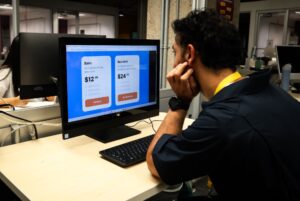Third to only Christmas and Mother’s Day, Valentine’s Day tops the charts of the year’s highest grossing holidays, clocking in at nearly $20 billion in consumer spending.
Despite the money being spent, the popularity of Valentine’s Day is actually waning. According to the National Retail Federation’s Consumer Survey, 54.8 percent of Americans celebrate Valentine’s Day, nearly 10 percent fewer than reported in 2007. The February 14th holiday continues to be lucrative, however, because the average consumer is spending more than ever. The NRF reports that the average shopper spends $147 on his or her sweetheart. Here are three business trends to research for Valentine’s-themed business articles.
Brick-and-mortar vs. online stores
Although brick-and-mortar stores still rule for romantic purchases, the number of shoppers turning to the internet for their Valentine’s Day gifts has been rising, and rapidly. According to the NRF, 28 percent of shoppers reported that they found a gift for their loved ones from an online store. And in some businesses, the future for retailers looks even more dramatic. For example, brick-and-mortar florists have declined by 41 percent since 2001. Meanwhile, online floral shops are quickly gaining traction. According to market research firm IBISWorld, online floral shops have increased their sales more than 6 percent in the last five years.
Spending on lovers and Labradoodles
Of the 54.8 percent of people who said they would celebrate Valentine’s Day last year, 90.8 percent planned to do their celebrating with a significant other or spouse. Valentine’s Day spending on other family members, friends, classmates and co-worker has declined since 2007, but gifts for four-legged friends is on the rise. Valentine’s Day treats for pets is now a $681 million industry.
A holiday perfect for procrastinators
Preparing for the Christmas holidays can start pretty early for many people. Valentine’s Day, on the other hand, sees most shoppers searching and buying gifts only two weeks ahead of time, with many waiting until the very last minute. According to Profitero Analytics, 46 percent of purchases are made in early February, and 30 percent of Americans delay their Valentine’s Day planning until February 14th.
Reporter’s Takeaway
• Find out which brick-and-mortar stores in your area may be impacted by the increase in online sales. For stores that continue to see successful Valentine’s sales, ask what types of benefits they offer consumers to entice them to shop locally.
• Talk to pet stores and pet owners to see what products are popular and if retailers see an increase in novelty sales right before Valentine’s Day.
• Interview store and restaurant owners to determine how busy they expect to be on Valentine’s Day; some may be extending hours or increasing staff. Also look into businesses offering special crafts workshops or celebration dinners Local hotels and spas that are planning to cash in on the holiday are other good sources for business stories.











